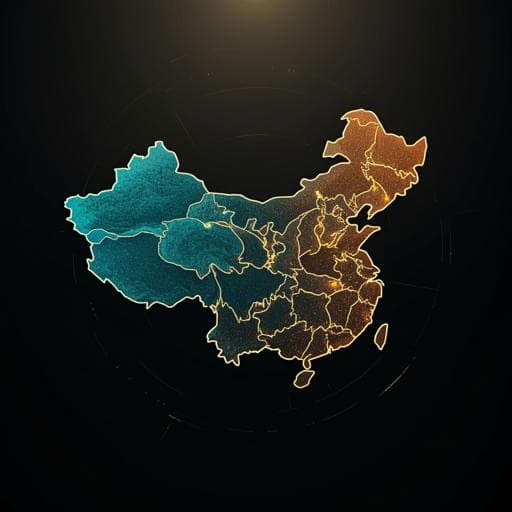
Social Work
Spatial and temporal changes in population distribution and population projection at county level in China
M. Sang, J. Jiang, et al.
This compelling study by Mei Sang, Jing Jiang, Xin Huang, Feifei Zhu, and Qian Wang explores the intricate dynamics of population distribution across China from 1953 to 2020. Utilizing advanced ArcGIS and ARIMA modeling, it uncovers alarming trends of urban concentration and regional decline, paving the way for crucial discussions on future resource allocation and strategic development.
~3 min • Beginner • English
Introduction
The paper addresses how China’s population has changed across space and time at the county level from the first to the seventh national population censuses and forecasts the national population trajectory. In the context of rapid globalization and accelerated urbanization, developing countries—particularly China—have experienced large-scale demographic shifts and urban concentration. Given China’s large population, rapid demographic transition, and aging, understanding spatial redistribution patterns and future dynamics is crucial for planning and policy. The research fills a gap by providing a nationwide, county-level analysis spanning all seven censuses, aiming to portray spatial distribution patterns, identify temporal evolution (growth, stability, negative growth), and provide evidence to support population management, urban–rural coordination, and sustainable development policies.
Literature Review
The study situates itself within population geography and spatial demography literature. Foundational work includes Hu Huanyong’s Heihe–Tengchong line delineating China’s southeast–northwest population contrast. Prior research spans global (e.g., Balk et al., Dobson et al., Ramankutty), national, and regional scales, focusing on population density, concentration, inequality (Lorenz/Gini), potentials, and spatial models. Scholars argue for multi-scale analyses beyond urban cores to capture redistribution in sparsely populated regions (Balsa-Barreiro et al.). For forecasting, two main model classes are noted: (1) demographic component-based (e.g., probabilistic fertility/mortality, Leslie matrices), and (2) time-series of total population (regression, grey GM, neural networks, combined models), with ARIMA widely used for short-term forecasts due to applicability and accuracy. The paper extends prior work by conducting a rare, comprehensive county-level analysis across all seven censuses and coupling spatial statistical measures with ARIMA-based national projections.
Methodology
Data: County-level resident population data from China’s 1st–7th national censuses; provincial census bulletins; China Statistical Yearbook; National Bureau of Statistics; county-level administrative boundaries from the Data Center for Resources and Environmental Sciences, Chinese Academy of Sciences. Spatial units: 2829 (1st–3rd censuses), 2830 (4th–6th), 2849 (7th). Hong Kong, Macao, and Taiwan excluded.
Measures and models:
- Population density (ADi = Pi/Ai): number of residents per unit area to capture intensity of population distribution.
- Spatial autocorrelation: computed using GeoDa with ArcGIS mapping. Global Moran’s I measures overall spatial correlation (range [-1,1]), with positive values indicating spatial clustering; negative values indicating dispersion; zero indicating randomness. Local spatial autocorrelation (LISA; Local Moran’s I) identifies local clusters and outliers, classifying counties into high-high, high-low, low-high, low-low, and not significant.
- Population–land Gini coefficient (GR): quantifies inequality between population distribution and land area across counties using Lorenz-curve-based formulation GR = 1 − Σ Pi(2Qi − Wi), after sorting by population density and grouping land area.
- ARIMA modeling: Time-series of China’s total population (1982–2022; n=41) modeled via ARIMA(p,d,q). Steps: (1) visualize and test stationarity (ADF unit-root test); (2) difference non-stationary series (determine d); (3) identify p, q via ACF/PACF; (4) estimate and diagnose model (white-noise residuals); (5) forecast 2023–2035. EViews 12 used. Final model selected: ARIMA(2,2,2) based on significance of parameters and residual diagnostics.
Key Findings
Spatial–temporal distribution and change:
- Average county population increased from 228,000 (1st census) to 498,000 (7th census). Largest average growth occurred between the 2nd and 3rd censuses (41.33%). Growth rates declined after the 4th; smallest between the 6th and 7th (5.64%).
- Heihe–Tengchong (Hu) line: Southeast share of national population decreased slightly from 94.94% (1st) to 93.70% (7th), while the northwest increased from 5.06% to 6.25%. The overall ratio remains about 94:6, confirming enduring east–west disparity.
- County size distribution: Proportion of counties with <100,000 inhabitants fell from 28.21% (1st) to 10.42% (7th), mainly in the northwest (Tibet, Xinjiang, Qinghai, Gansu, Inner Mongolia, Sichuan). Counties with >500,000 inhabitants rose from 8.52% (1st) to 36.85% (7th), concentrated southeast of the Hu line (Yangtze River middle–lower plains, North China Plain, PRD, YRD, Sichuan Basin).
- Growth vs decline by intercensal period: At least 40% of counties grew between any two adjacent censuses. Peak growth occurred from 2nd→3rd censuses (96.43% of counties grew). From the 3rd census onward, the share of growing counties declined; the 6th→7th period had the lowest share growing (46.64%). For 6th→7th: 1301 counties grew (45.97%), including 483 with >20% growth (17.07%); 1529 counties declined (54.03%), including 288 with >20% decline (serious loss), concentrated in Heilongjiang, Jilin, Liaoning, central/northeastern Inner Mongolia, and eastern Sichuan. Growth concentrated in southeastern coastal and economically developed areas (incl. Beijing–Tianjin), with some Xinjiang and Tibet areas also growing strongly.
Spatial autocorrelation:
- Global Moran’s I for rate of change: 1st→2nd: 0.189; 2nd→3rd: 0.011; 3rd→4th: -0.002; 4th→5th: 0.017; 5th→6th: 0.074; 6th→7th: 0.189. After the 4th census, Moran’s I increased, indicating strengthening spatial clustering of change.
- LISA (6th→7th): 138 high–high clusters primarily around provincial capitals and major cities (e.g., Changchun, Qingdao, Zhengzhou, Wuhan, Changsha, Chengdu, Nanjing–Suzhou–Wuxi, Hangzhou–Ningbo, Guiyang, Nanning, Guangzhou, Xiamen, cities in Tibet); 361 low–low clusters in the northeast, southeast Gansu, central Inner Mongolia, south Shaanxi, east Sichuan, and central Yunnan. Indicates enhanced agglomeration capacity of provincial capitals and contraction in the northeast and underdeveloped western border regions.
Density–growth coupling and regional types (6th→7th census examples):
- Low-density areas concentrated in the three northeastern provinces, southern Yunnan, the Qian–Gui junction, and northwest of the Hu line. Counts: low-density negative growth: 408 counties (14.42%); low-density stable growth: 220 counties (7.78%); low-density rapid growth: 39 counties (small share), found in parts of Xinjiang (Hami, Changji, Hotan, Aksu), Tibet (Lhasa, Ali, Linzhi, Chamdo), Sichuan/Qinghai (Ganzi, Golog), Inner Mongolia/Shaanxi (Ordos, Yulin).
- High-density areas located in the North China Plain, Yangtze River middle–lower plains, southeastern coast, and Sichuan–Chongqing border. Counts: high-density negative growth: 344 counties (12.16%), in eastern Tianjin, central Hebei, north/central Henan, central Shaanxi, central Jiangsu, central/southern Shandong, eastern Sichuan, parts of Hubei/Hunan, and eastern Guangdong; high-density stable growth: 11.81% of counties (mainly Shandong, Henan, Hebei, southeastern coast); high-density rapid growth: 278 counties (9.83%) across major metropolitan nodes (e.g., Beijing, Tianjin, Chongqing, Xi’an, Zhengzhou, Changsha, Chengdu, Kunming, Jinan, Linyi, north Zhejiang, south Jiangsu, east Fujian, east Guangdong).
- Long-run evolution pattern across censuses: low-density rapid growth → medium-density rapid growth → stable growth → negative growth, indicating approach to an inflection point and likely slowdown/decline in total population.
Population–land inequality and concentration:
- National population–land Gini coefficient remained high (>0.7) across censuses; lowest at the 4th census (0.7504) and 7th census at 0.7896. The Gini rose from the 4th to the 7th, with a rapid increase of about 0.0388 since the 3rd, indicating accelerating concentration.
- By Hu line halves: southeast half Gini ≈ 0.5; northwest half ≈ 0.8, about 1.6× higher in the northwest, highlighting stronger imbalance there.
- Density concentration metrics: counties with density >500 persons/km² increased from 373 to 957; their share of national population rose from 21.59% to 53.88%, while their land area rose from 1.41% to 6.74%. Counties with density >150 persons/km² increased from 1314 to 1845; these areas’ population share rose from 68.06% to 85.5%, occupying 23.55% of land by the 7th census (up from 13.15%). Roughly 24% of China’s land now supports about 86% of the population.
ARIMA-based national population forecast:
- Stationarity: original series non-stationary (ADF t = -2.4156; p = 0.1442). After second differencing, stationary (ADF t = -5.4904; p = 0.0001). Selected model ARIMA(2,2,2) with significant parameters (AR(1), AR(2), MA(1), MA(2), constant all p<0.05) and white-noise residuals.
- Projection: China’s population declines from 1410.05 million in 2023 to 1343.68 million by 2035, consistent with observed entry into negative growth post-2022.
Discussion
Findings demonstrate persistent and intensifying spatial concentration of China’s population, with growth increasingly clustered in and around provincial capitals, major metropolitan areas, and the southeastern coastal belt, while many northeastern and western border counties face sustained decline. The enduring 94:6 southeast–northwest split across the Hu line confirms the powerful imprint of natural, economic, and administrative factors on population distribution. Rising Moran’s I and Gini coefficients signal strengthening agglomeration and imbalance. The temporal sequence from low-density rapid growth to medium-density growth, stability, and negative growth aligns with China’s demographic transition and implies mounting pressures on regional economies, labor markets, and social services in shrinking areas. The ARIMA projection indicates continued national population decline through 2035, underscoring the urgency of policy responses. These insights are directly relevant for regional planning, urban–rural integration, infrastructure allocation, and strategies to address population loss, especially in the northeast and border regions, while leveraging the agglomeration advantages of core cities to optimize population spatial layout and improve productivity.
Conclusion
The study builds a county-level population database spanning the 1st–7th censuses, applies spatial statistical tools (global/local Moran’s I, population–land Gini) to reveal increasing population concentration and widening spatial disparities, and employs an ARIMA(2,2,2) model to forecast national population decline to about 1.344 billion by 2035. Key contributions include: (1) a comprehensive, long-run county-scale portrait of China’s population distribution and evolution; (2) evidence of growing spatial agglomeration and imbalance across the Hu line and within metropolitan systems; and (3) a transparent time-series forecast corroborating entry into negative growth after 2022. Policy implications emphasize adapting to an era of shrinking populations in many counties by rationalizing spatial layouts, improving infrastructure and basic public services, and reorienting development strategies to treat contraction as an opportunity for transformation. Future research should analyze causal drivers with specific indicators, examine subregional dispersion characteristics (e.g., east/middle/west; north/south; southeast/northwest/southwest), and extend analyses to township-level data for finer-grained spatial understanding.
Limitations
- The study does not quantitatively model specific drivers (e.g., economic, environmental, institutional) of population change via indicator-based analyses.
- It does not perform detailed subregional (east, middle, west, north, south, southeast, northwest, southwest) comparisons of dispersion patterns.
- The analysis is at the county level; township-level data (the smallest publicly released census unit) could provide more detailed spatial depictions. Further work should incorporate township-level analyses.
Related Publications
Explore these studies to deepen your understanding of the subject.







